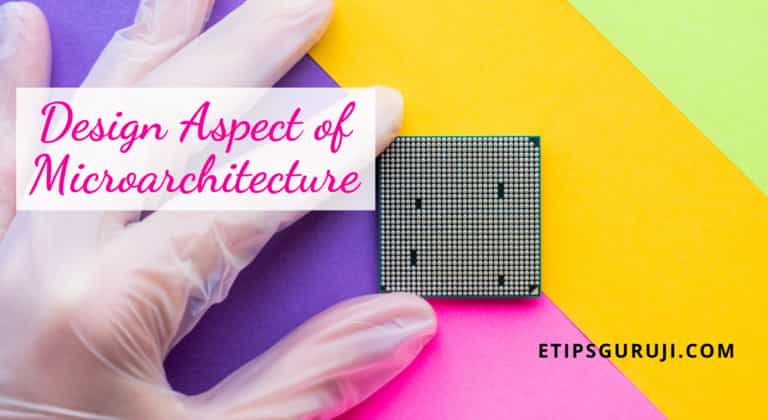Microarchitecture: Definition, Design & Components

In this short post, we are going to dig deeper into the architectural aspect of a processor i.e Microarchitecture definition.
What is Microarchitecture?
The Microarchitecture definition is as follows:
The term “Microarchitecture” is sometimes written with dash i.e. “micro-architecture” but both of them are abbreviated as “µarch”.
The word “µarch” with ‘µ’ is a Greek letter pronounced as “mu” which scientifically represents the term “micro”. Thus, it combinedly formed micro + architecture. However, some keyboard doesn’t have ‘µ’ letter in it, so for sake of easiness, it is also called as “uarch”
That’s a bundle of knowledge for the “microarchitecture” word itself. Let’s now take a look at its definition.
A microarchitecture is a digital logic of a combined entity of registers, memory, arithmetic logic units, multiplexers, and any other digital logic blocks that altogether allow an instruction set to be executed on command. This combinedly sums up to form a processor. This is the Microarchitecture meaning.
In addition, these microarchitectures are combined with ISA (Instruction Set Architecture) to make the whole system an architecture module for executing the sets of commands.
People Also Read:
- Is my windows 32 or 64 bit? How to Determine Bit Version Easily
- What is a Good Processor Speed? For Gamers & Video Editing Work
Design Aspect of Microarchitecture

In Microarchitecture Design, there are various datapaths that are used for building a processor but pipelined datapath is the most widely used in today’s world.
With this microarchitectural design, it does not only help in building the microprocessor but also microcontrollers and DSP (Digital Signal Processor).
However, there are some components that are necessary for the microarchitecture of a processor. These are as follows:
Registers
It is a type of computer memory that processes the data very quickly which is used by the CPU. A register can process data by quickly accepting, storing, and transferring data and other instructions to the CPU.
These registers usually hold the memory address of the data on which the processor computes the command.
There are commonly eight types of registers such as Data register (DR), Address register (AR), Accumulator (AC), Instruction register (IR), Program counter (PC), Temporary register (TR), Input register (INPR), and Output register (OUTR)
Arithmetic Logic Units (ALU)

An ALU is called to be the fundamental building block of a microarchitecture processor. As per the name, they are used to perform arithmetic and logic operations.
An ALU is a digital circuit by which these operations are performed. And as these digital circuitries becomes powerful and complex, the more powerful the processor is.
These ALU digital circuitries pull data from the registers to perform logical and arithmetic operations that are controlled by the integrated control unit (CU).
In general, there are three main operations that are controlled by ALU such as:
- Logical operations: Operations like AND, OR, NOT, etc.
- Bit-Shifting Operations: Shifts the positions of the bits by a certain number of places, for multiplication or division operations.
- Arithmetic Operations: Usually for addition and subtraction but sometimes also depict multiplication and division (in commands where both subtraction and multiplication rules are required)
Memory Controller (MC)
It is also a digital circuit of a microarchitecture that manages the flow of data that is processed by the computer’s main memory. They are integrated into CPU architecture to process the logic operations necessary to read and write on DRAM.
Multiplexers (MUX)
A multiplexer (Mux) is a device that is used as a selection tool to select a single line of input from multiple input lines using control signals.
In other words, it is a logic digital circuit design to switch one of the several inputs channels into a single common output channel using the control signal, but one at a time.
Also Read:
- What Motherboard do I have? – Step by Step Guide
- Why My Computer Work Slow All Of A Sudden? 11 Tips Included
Types of Microarchitecture
Two types of microarchitecture were used: geometric or trabecular. These are also the types in computer architecture.
Microarchitecture Examples
The micro-architecture is the very specific design of a microprocessor, while a chip’s architecture refers to the broader family of chips. For example, Intel’s x86 family is the architecture, while NetBurst, Nehalem, etc. are micro-architectures.
General FAQs
What are the examples of an Intel microarchitecture?
Intel micro-architecture dictates the generation of the processors. Some recent micro-architectures are Skylake, Goldmont, Kaby Lake, Coffee Lake, Comet Lake, Sunny Cove (Ice Lake), Tremont (Lakefield, Snow Ridge), and so on…
What is the difference between ISA and microarchitecture?
ISA (instruction set architecture) is the set of instructions that are supported by a processor such as x64, x86. Whereas, micro-architecture is concepts that deal with how the ISA is implemented.
Conclusion
With this our informative post on “Microarchitecture” ends. But be sure to check our other informative articles related to computer science and information technology.
If you found this article usefull, then share our post!
Finally, thanks for reading our post!
